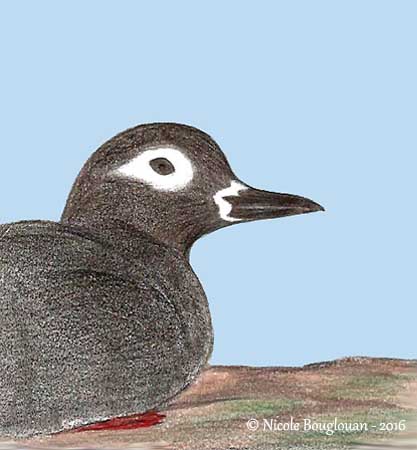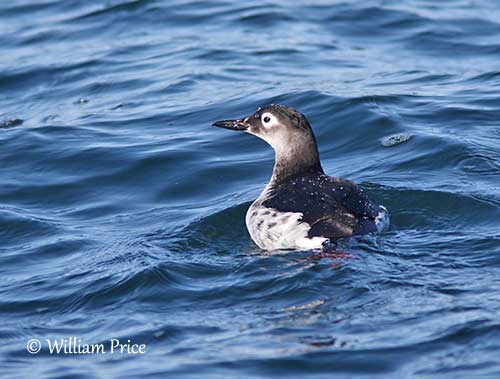
Fr: Guillemot à lunettes
Ang: Spectacled Guillemot
All: Brillenteiste
Esp: Arao de Anteojos
Ita: Uria dagli occhiali
Nd: Brilzeekoet
Sd: Glasögontejst
Photographe:
William Price
PBase-tereksandpiper & Flickr William Price
Illustration and text by Nicole Bouglouan
Sources:
HANDBOOK OF THE BIRDS OF THE WORLD Vol 3 by Josep del Hoyo-Andrew Elliott-Jordi Sargatal - Lynx Edicions - ISBN: 8487334202
OISEAUX DE MER – Guide d’identification de Peter Harrison – Editions Broquet (Canada) – ISBN-10 : 2890004090 – ISBN-13 : 978-2890004092
Ocean Wanderers "Ride the Wave"
Bird Research News by Yoshihiro FUKUDA - Shiretoko Seabird Society
Birds of East Asia by Mark Brazil
Spectacled Guillemot
Cepphus carbo
Charadriiformes Order – Alcidae Family
INTRODUCTION:
The Spectacled Guillemot is endemic to NE Asia. It is the largest guillemot of genus Cepphus that includes two other species, the Black Guillemot and the Pigeon Guillemot.
This species breeds among rocks on rocky coasts, and winters in ice-free areas off the breeding range, and sometimes in bays and harbours. It rarely breeds in large colonies, preferring small groups with scattered pairs, or nesting solitary.
The Spectacled Guillemot is threatened by predation by invasive species and lack of food availability.
DESCRIPTION OF THE BIRD:
Biometrics:
Length: 38 cm
Wingspan: 65-70 cm
Weight: 575-760 g
The Spectacled Guillemot in breeding plumage has sooty to blackish-brown plumage overall. On the head, we can see a conspicuous white area around the eye, extending to the ear-coverts and giving the bird its name. There is a smaller white area around the base of the bill.
The black bill is robust and pointed. The eyes are dark brown. Legs and webbed feet are red.

The juvenile resembles adult in winter, but it has whiter throat and the underparts are barred brownish-black.
RANGE:
The Spectacled Guillemot breeds on coasts and several islands from Kamchatka and Sea of Okhotsk, S to NE Korea, Kuril Islands and N Japan (Hokkaido).
It often winters off the breeding grounds or farther S, and may occur in bays, harbours and headlands.
HABITAT:
The Spectacled Guillemot breeds on rocky coasts, in cliffs, slopes and boulder fields and on islands, usually close to shallow water for foraging. During winter, it is more pelagic and often occurs along the coasts, but they remain in the vicinity of their breeding areas.
CALLS AND SONGS:
The Spectacled Guillemot gives soft, melodious whistles, typical of Cepphus guillemots. During the breeding season, it utters high-pitched, tremulous whistles “piii piii” or more rapid “fi-fi-fee-fee” given on the ground, at sea or even inside the nesting cavity.
We can see the bright red mouth lining while the bird is calling.
BEHAVIOUR IN THE WILD:
The Spectacled Guillemot feeds mainly on fish, marine invertebrates and crustaceans. The fish diet includes a variety of benthic species. The Cepphus guillemots catch and swallow the small prey usually while swimming, and sometimes chase mobile prey at sea bottom on sandy floor. They also take sardines and herrings, and some invertebrates.
The Spectacled Guillemot feeds along the coasts in the surroundings of its nesting areas. During the breeding season, the adults often forage within 6 kilometres from the nesting sites, at depths of 15-20 metres, and generally less than 50 metres.
The Spectacled Guillemot is probably monogamous. It nests in groups of 10-20 scattered pairs, but sometimes it may nest solitary. It nests in rock crevices, holes and natural cavities in rocky habitat such as cliffs, scree slopes and boulder fields, and on islands.
The courtship displays are unknown. The copulation usually occurs in the open, at or near the breeding site.
The Spectacled Guillemot is mostly sedentary and winters in the surrounding of the colonies. The northernmost birds of Sea of Okhotsk are often forced southwards by ice formation.
The Spectacled Guillemot produces whirring noises with the wings during the rapid, direct flight.
The Spectacled Guillemot in winter plumage has white underparts. The face is blackish with reduced white eye area. Head and neck sides are mostly dark grey, whereas forehead and crown are black. Wings and tail are black.
Male and female are similar. They are plump, with long, thick neck and short tail.

REPRODUCTION OF THIS SPECIES:
The breeding season starts in May, with hatching in mid-June/early July. The chicks fledge from late July to early August.
The Spectacled Guillemot nests in rocky cavities, holes and crevices in cliffs and steep rocky slopes or reefs, usually from 1,5 to 20 metres above the high water line.
The female lays two eggs, sometimes only one. Both adults share the incubation during 27-29 days. The nestling period lasts 40-45 days in NW Hokkaido, but this period may vary from 43 to 53 days.
PROTECTION / THREATS / STATUS:
The Spectacled Guillemot is threatened by introduced predators. Eggs and chicks are taken by Corvidae, gulls and sometimes Eurasian Eagle-Owl and Peregrine Falcon. Introduced mammalian predators can cause the abandon of colonies.
Other threats such as reduction of food availability due to overfishing, human disturbance, illegal hunting, oil-spills and fishing nets may cause some decline.
The global population is estimated to number 140,000/148,000 individuals and is suspected to decline.
But currently, the Spectacled Guillemot is evaluated as Least Concern.
